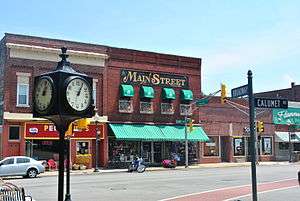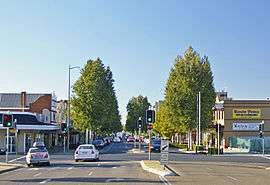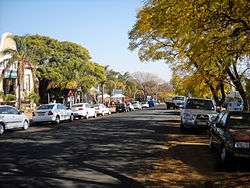Main Street

Main Street is a generic phrase used to denote a primary retail street of a village, town or small city in many parts of the world. It is usually a focal point for shops and retailers in the central business district, and is most often used in reference to retailing and socializing.
The term is commonly used in Ireland, Scotland, the United States, Canada, and less often in Australia and New Zealand. In most of the United Kingdom the common description is High Street. However, the term "Main Street" is sometimes used in the UK.[1] In Jamaica the term is Front Street. In some parts of the south west of England the equivalent used is "Fore Street", or in the north east "Front Street".
In many places, the street name for such a street is actually "Main Street", though even where it isn't the term "Main street" is still used to describe the main thoroughfare of the central business district. The "Main Street of America" branding was used to promote U.S. Route 66 in its heyday.
American cultural usage

In the general sense, the term "Main Street" refers to a place of traditional values. Social realists from 1870 to 1930 used the name as a symbol of stifling conformity.[2] Sherwood Anderson, for example, wrote Winesburg, Ohio: A Group of Tales of Ohio Small Town Life in 1919. The best-selling 1920 novel Main Street was a critique of small town life, by the American writer Sinclair Lewis. The locale was "Gopher Prairie," presented as an 'ideal type' of the Midwestern town, and the heroine, Carol Kennicott, was a more urbane, 'ideal-typical' Progressive.[3]
In North American media of later decades, "Main Street" represents the interests of everyday people and small business owners, in contrast with "Wall Street" (in the United States) or "Bay Street" (in Canada), symbolizing the interests of large national corporations. Thus, in the 1949 movie adaptation of On The Town, the song "When You Walk Down Main Street With Me" refers to small-town values and social life. Main Street Republicans for example, see themselves as supporting those values as against urbane or "Wall Street" tendencies.
"Main Street" is part of the iconography of American life. For example, the Army and Air Force Exchange Service, the outfit that operates the PX and BX stores on military bases, chose the name "Main Street USA" for its food courts.
Main Street was a popular term during the economic crises in 2008 and 2009: the proposed bailout of U.S. financial system, the 2008 US presidential campaign, and debates. One widely reviewed book was Bailout: An Inside Account of How Washington Abandoned Main Street While Rescuing Wall Street (2012) by Neil Barofsky.
In small towns across the United States, Main Street is not only the major road running through town but the site of all street life, a place where townspeople hang out and watch the annual parades go by. A slang term popularized in the early 20th century, "main drag", is also used to refer to a town's main street.
Walt Disney
Two Walt Disney Company theme parks, Disneyland in Anaheim, California, and the Magic Kingdom in the Walt Disney World Resort near Orlando, Florida, both have "Main Street, U.S.A." sections immediately at their front. These areas, which are designed to look like the main street of a small town, house gift shops, restaurants and various services, along with park offices on the second floors. While the architecture of these "streets" appears to be turn-of-the-20th-century, in fact these are decorative false-fronts on industrial-style buildings. Main Street, U.S.A. is also present at Disneyland Paris and Hong Kong Disneyland. At Tokyo Disneyland the area is named "World Bazaar," but has the same look as Main Street, albeit housed under a decorative glass roof for protection from Japan's unpredictable weather.
Disney's design copied visual elements of small-town America seen in films by Frank Capra and others, in a deliberate attempt to capture the iconic symbolism of small-town America. Disney wanted to embed the values and memories associated with life in small towns into an entertainment experience for tourists.[4]
Preservation and Main Street
Main Street Inc. is the name of a community revitalization program begun by the National Trust for Historic Preservation in the late 1970s. The core of the Main Street philosophy is the preservation of the historic built environment by engaging in historic preservation. Main Street focuses on a holistic approach to revitalization based on the 4-point approach of design, promotion, economic restructuring, and organization. Originally targeted at small, traditional downtowns, the program has expanded to include towns of various sizes, including neighborhood districts in several large urban centers.[5]
In many communities, a merchants' association or business improvement district serves a promotional role on behalf of the merchants of a downtown Main Street. Individual city governments also may engage in revitalisation or historic preservation efforts to support a downtown core, either to make a community appear more attractive for tourism or to stem a flow of commerce out of the city into suburbs with shopping malls and cookie-cutter big box stores.
In the United States federal funds are allocated specifically for restoration of historic properties on the former U.S. Route 66, the main street of many roadside towns; this funding is administered by the US National Park Service.[6]
International use and equivalents
- Many small Canadian cities and towns have a thoroughfare named Main Street (or, in French, Rue principale); in other cases, the main street of the community has a name particular to that community. The phrase "a town where the main street is still called Main Street" is occasionally used as being synonymous with small-town values.
- In Ottawa, main streets of various individual villages which had been annexed to the larger urban municipality bear names like "Manotick Main" or "Osgoode Main" to distinguish them from Smyth Road (which becomes "Main Street" in one small area southeast of downtown Ottawa) and from each other. The actual main street of centretown Ottawa is Bank Street.
- In Toronto, however, Main Street is a mostly residential avenue in the city's east end.[7][8][9] (At one time it was the main street of the hamlet of East Toronto, which was annexed by the city of Toronto in 1908. It has kept its historic name, and evidence of its commercial origins can be seen in the stores at the corner of Main and Gerrard Streets.) Toronto's main street is Yonge Street.
- Saint Laurent Boulevard, which divides Montreal between east and west, is unofficially known as "the Main."
- Main Street in Vancouver is a neighbourhood shopping street, near the dividing line between east and west side of town. However, the city's main city centre shopping street is Robson Street.
- In Australia and New Zealand, smaller urban centres often have a main street. In some towns this street is officially designated Main Street or High Street; rarer variants include Main Road, Commercial Road, and Commerce Street. Often, though, the street is given a name peculiar to the town. For many small towns, the main street forms part of the principal road into, or through, the town. Large centres often have a central business district in which no one street is a clear focus for commercial activity, though for historical or cultural reasons there is often one street regarded as the city's "main street". Examples include Melbourne's Collins Street, Sydney's George Street, Adelaide's King William Street, Auckland's Queen Street, and Christchurch's Colombo Street.
- In Ireland most towns have a "main street", and this is usually the term given colloquially (for example, in offering road directions), though the primary thoroughfare of cities are often named after an historical figure, e.g. O'Connell Street. A more recent phenomenon in the media and with younger people is the misapplication of the term "high street" to describe typical or average street level fashion—likely due to advertising by various British retail multiples which began operating in Ireland during the "Celtic Tiger" years.
- In England, the terms "Market Street" or "Market Place" are often used to designate the heart of a town or city, as is the more common High Street (particularly in newer urban developments, or towns or cities which were not original market towns). High Street is often the name of a fairly busy street with small shops on either side, often in towns and villages.
- In Germany, the Hauptstraße (literally "Main Street") is a highly trafficked street. Hauptstraßen even have formal recognition in road construction guidelines, which specify the width of lanes, for example. The term chiefly refers to motorized traffic, whereas "Einkaufsstraße" (shopping street) or "Fußgängerzone" (pedestrian district) refer to retail in the sense of Engl. "Main Street".
- In Sweden and Norway, almost all towns and cities have their own main street, a street called Storgatan/Storgaten (literally, "The big street"). They are typically surrounded by stores and restaurants, and increasingly since the late-20th century open for pedestrians only. Likewise, in both Sweden and Norway this type of street is called gågata/gågate (literally, "walkingstreet").
- In most Italian municipalities, the highway or another major route is called Via Roma. This was done at the behest of Benito Mussolini, who gave the order in 1939 to commemorate the March on Rome.
- Jalan Besar (roughly translated from Malay as "Main Road") is a common street name used in Malaysia (and to a more limited extent, Singapore) when referring to main streets of older urban centres in the country. Such main streets were originally constructed during British colonisation of territories in present-day Malaysia and Singapore, and were named in English as "Main Street" or "Main Road", depending on the size and nature of the urban centre, and often are laid out as parts of major thoroughfares between larger towns and cities.
- The independence of states that would form Malaysia and the introduction of the Malay language as the country's national language in 1967 led to extensive renaming of certain Main Streets or Main Roads to "Jalan Besar" in Malaysia the following decades. Large cities (such as state capitals) tend to forgo the use of "Main Street" or "Main Road" altogether as commercial or transport activity may be concentrated along more than one street.
- In South Africa, Main Road is the term used for the same concept as Main Street in the U.S. and High Street in the UK.
- In Cambodia, the Main Road is between the Rice fields and settlements.
Gallery
 Main street (Hungarian: Főutca, literally "Principal Street") in Budapest, Hungary (by Antal Berkes)
Main street (Hungarian: Főutca, literally "Principal Street") in Budapest, Hungary (by Antal Berkes) Main Street in Chesterton, Indiana
Main Street in Chesterton, Indiana Main Street, Belfast, Maine
Main Street, Belfast, Maine Elm Street, Manchester, New Hampshire, is the "main street" of the downtown central business district.
Elm Street, Manchester, New Hampshire, is the "main street" of the downtown central business district.
 Baylis Street, the Main Street of Wagga Wagga, New South Wales
Baylis Street, the Main Street of Wagga Wagga, New South Wales The Main Street of Cullinan, South Africa
The Main Street of Cullinan, South Africa- Looking across Main Street in Queens, New York, United States, at a post office. All five boroughs of New York City have streets named "Main Street", but this is the only one that is an arterial road.
See also
References
- ↑ Needs source
- ↑ Ruth Ann Alexander, "Midwest Main Street in Literature: Symbol of Conformity," Rocky Mountain Social Science Journal (1968) 5#2 pp 1-12
- ↑ Hans-Jürgen Grabbe, "The Ideal Type of the Small Town: 'Main Street' in a Social Science Context," Amerikastudien (1987) 32#2 pp 181-190.
- ↑ Robert Neuman, "Disneyland's Main Street, USA, and its Sources in Hollywood, USA," Journal of American Culture (2008) 31#1 pp 83-97, online
- ↑ "Home Page". Main Street. National Main Street Center. 2009-04-09.
- ↑ "Discover Our Shared Heritage Travel Itinerary: Route 66". US National Park Service.
- ↑ Edward Relph (2014). Toronto: Transformations in A City and its Region. University of Pennsylvania. Retrieved 2014-02-20.
The names of many of the old municipalities have been preserved in business improvement areas, and, for example, Main Street subway station refers to the main street of East Toronto.
- ↑ Ron Brown (2013). Rails Across Ontario: Exploring Ontario's Railway Heritage. Dundurn Press. p. 19. ISBN 9781459707542.
Many wonder why there is a "Main Street" in Toronto's east end. This too came about when the GT selected a tract of land to create another sea of railway sidings. While it named its yard "York," the town that grew nearby was incorporated as "East Toronto" and the commercial main street became "Main Street."
- ↑ Mike Filey (2008). Toronto: The Way We Were. Dundurn Press. p. 209. ISBN 9781550028423. Retrieved 2014-02-20.
One remnant of the ancient hamlet was the retention of the name of one of its original thoroughfares. That's why there's still a Main Street several miles east of Yonge, Toronto's original main street.
Further reading
- Orvell, Miles. The Death and Life of Main Street: Small Towns in American Memory, Space, and Community (University of North Carolina Press; 2012)
- Poll, Ryan. "Main Street and Empire: The Fictional Small Town in the Age of Globalization." New Brunswick, NJ: Rutgers University Press, 2012.
Primary sources
- Davies, Richard et al., eds. A Place Called Home: Writings on the Midwestern Small Town (2003) 34 selections of cultural history, fiction, and poetry, both classic and contemporary
External links
| Wikimedia Commons has media related to Main Street. |
- Mapping Main Street - a collaborative documentary media project that creates a new map of the country through stories, photos and videos recorded on actual Main Streets
- Schneider-Cowan, Joy. "A Case Study of the San Marcos Main Street Program" (2007). Applied Research Projects. Texas State University. Paper 268.